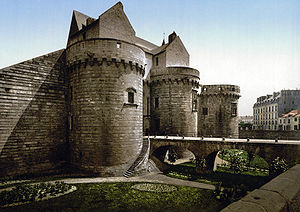- Château des ducs de Bretagne
-
Château des ducs de Bretagne
Castle of the Dukes of BrittanyNantes, Pays de la Loire, France 
Entrance as it appeared between 1890 and 1905Type Fortified château Coordinates 47°12′57″N 1°33′0″W / 47.21583°N 1.55°WCoordinates: 47°12′57″N 1°33′0″W / 47.21583°N 1.55°W Built 1207, rebuilt 1466 Built by Guy of Thouars, Duke of Brittany In use 1207 - 1862 Current
conditionRestored Current
ownerVille de Nantes Open to
the publicYes Controlled by Brittany until 1532, France until present Events Edict of Nantes - This article includes information translated from the Wikipedia article Château des ducs de Bretagne
The Château des ducs de Bretagne (English: Castle of the Dukes of Brittany) is a large fortified château located in the city of Nantes in the Loire-Atlantique département of France; it served as the centre of the historical province of Brittany until its separation in 1941. It is located on the right bank of the Loire, which formerly fed its ditches. It was the residence of the Dukes of Brittany between the 13th and 16th centuries, subsequently becoming the Breton residence of the French Monarchy.
The castle has been listed as a monument historique by the French Ministry of Culture since 1862. Today the castle houses the Nantes History Museum.
The old keep
Contents
Restoration
Starting in the 1990s, the town of Nantes undertook a massive programme of restoration and repairs to return the site to its former glory as an emblem of the history of Nantes and Brittany. Following 15 years of works and three years of closure to the public, it was reopened on 9 February 2007 and is now a popular tourist attraction.
The restored edifice now includes the new Nantes History Museum, installed in 32 of the castle rooms. The museum presents more than 850 objects of collection with the aid of multimedia devices. The castle and the museum try to offer a modern vision of the heritage by presenting the past, the present and the future of the city. Night-time illuminations at the castle further reinforce the revival of the site.
The 500 metre round walk on the fortified ramparts provides views not just of the castle buildings and courtyards but also of the town.
Seven sequences of the museum
- The Castle, Nantes and Brittany back to the 17th century
- Nantes, daughter of the river and the ocean
- Commerce and the black gold in the 18th century
- Nantes in Revolution
- A colonial and industrial port (1815–1940)
- A new city takes shape (1940–1990)
- A great Atlantic city, today and tomorrow
The exhibition ends with a vision of the city, a multimedia creation by a contemporary artist, occupying the entire area of the 32nd room. Pierrick Sorin is the first guest artist.
The illuminated Castle
The night-lighting brings out the architectural complexity of the site within an urban context. The illumination was designed by Sylvie Sieg and Pierre Nègre of the Atelier Lumière and won the Light Originator Price of the Lumiville Trophy 2007.
See also
External links
- Official website (English)
- Nantes Metropole Tourism Office (English)
- Ministry of Culture database entry for Château des ducs de Bretagne (French)
- Ministry of Culture photos
- visite virtuelle 360 photo panoramique
- castle pictures gallery
Bibliography
- Le château des ducs, Nantes et la Bretagne, Guy SAUPIN, 2010.
Sources
Gallery
 The courtyard of the château, from left to right; le Grand Gouvernement, which served as the residence of the governors of Brittany, otherwise known as le Palais Ducal; La Conciergerie, currently Caretaker's Lodge, but housed first the lieutenant of the duke, then the castle's arsenal of weapons; Le Harnachement, also used to store artillery, now an exhibition centre; Le Petit Gouvernement, the former home of the king of France on his visits to Nantes; and to the side, Les Murailles Extérieures, the walls of the castle. In the left background lies the Cathedral of St. Peter and St. Paul
The courtyard of the château, from left to right; le Grand Gouvernement, which served as the residence of the governors of Brittany, otherwise known as le Palais Ducal; La Conciergerie, currently Caretaker's Lodge, but housed first the lieutenant of the duke, then the castle's arsenal of weapons; Le Harnachement, also used to store artillery, now an exhibition centre; Le Petit Gouvernement, the former home of the king of France on his visits to Nantes; and to the side, Les Murailles Extérieures, the walls of the castle. In the left background lies the Cathedral of St. Peter and St. Paul Categories:
Categories:- Buildings and structures in Nantes
- Châteaux of the Loire Valley
- Châteaux in France
- Official historical monuments of France
- History of Brittany
Wikimedia Foundation. 2010.



